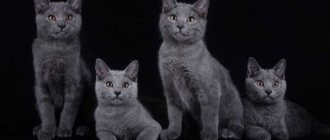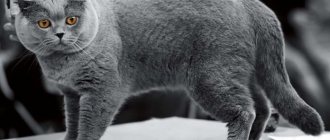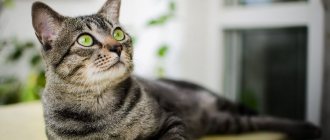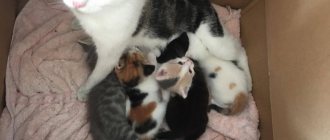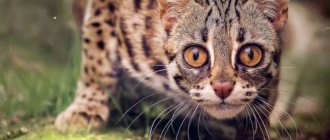Home » Cats » Cat breeds » Anatolian cat: history of origin and features of the Turkish breed
For European countries, the Anatolian cat is considered exotic. Its main habitat is sunny Türkiye. The breed is considered the most suitable for home keeping. Independence, unpretentiousness, sociability and a sharp mind make the animal ideal for cat lovers.
Origin story
The pedigree of the Anatolian breed goes deep into the past. The natural formation of the species occurred in the Armenian Highlands around Lake Van. The ancestors of modern "Anatolians" were domesticated in Eastern Anatolia (now Turkey). Since then, the breed has undergone some changes at the genetic level; modern cats have taken from their ancestors temperament, excellent health and a high level of intelligence.
Today the Anatolian cat is considered the pride of Turkey. It was first shown to Europeans in 1995 at a German exhibition. It was then that breeders became interested in the breed. Having acquired several individuals, they began breeding and after 5 years the “Anatolians” were officially recognized by the WCF cat association.
Origin of the breed
Representatives of this breed are of Turkish origin, which explains its second name - Turkish Shorthair cat. The ancestors of modern animals led a free lifestyle in the eastern regions of Anatolia - the Asian possessions of Turkey. In this country, the fact of the appearance of the breed is still a source of special pride. The habitat of these wild cats was limited to Lake Van. The Anatolian cat breed is the result of natural evolutionary changes and the subsequent domestication of their wild ancestors.
Today, many of these animals have returned to the wild, so cats with their characteristic features are often found in the lower, warmer regions of Turkey, from Iran to the Caucasus and Iraq, including Armenia, Azerbaijan and southern Russia. Being re-wild, these animals are of great value.
This is explained by their closeness to the so-called wild type of domestic cat. The fact is that American geneticists, in the course of large-scale research, came to the conclusion that the newly feral Anatolian cats are the descendants of the oldest domesticated cats, which indicates that their domestication took place in this region, and not in Egypt, as was previously believed.
Description of external breed standards
To a non-professional breeder, Anatolian cats will seem inconspicuous and unremarkable. However, professionals know what sets the breed apart from its peers. Anatolies are similar to the “Turkish Van”, but differ from them in having shorter hair. According to the standards of the World Cat Federation, a purebred “Anatolian” must meet the following parameters:
- large or medium-sized muscular body, but weak bone structure, wider in front than in back. The average weight of an adult is 5 kg, sometimes reaching up to 7 kg.
- The tail is of medium length, slightly tapering towards the tip. Limbs with well-developed muscles, the front ones are slightly spaced, which makes the gait predatory, the paws are rounded;
- the head has the shape of a triangle, the profile is straight, the chin is developed, the cheekbones are high and well defined;
- slanting, large, oval-shaped eyes set slightly wide. The color can vary from golden to green. Individuals with a white color have multi-colored eyes, one is light green, the other is blue;
- The ears are medium-sized, wide at the base, tapering towards the tip;
- The coat is short, a little harsh, but pleasant to the touch. It has a small undercoat and is water-repellent, allowing cats to dry quickly.
Anatolian cat with different colored eyes
As for color, it is varied. The standard accepts any colors except Siamese, brown, chocolate and lilac, although such shades are prized among breeders. Most often, the base color is white, on which multi-colored spots are scattered: cream, red, brown and black. There are solid colors: blue, black, cream. Bicolor, tricolor, and tabby are common. On the tail, the hair is longer and always darker in color than the overall tone. A distinctive feature of the breed are the markings on the ears, forehead and tail. On the muzzle the spots are separated by a vertical white stripe.
Appearance and breed characteristics
The WCF standard describes Anatolians as medium-sized cats, weighing 3-7 kg. Males are more massive and heavier than cats by about 1-2 kg. The muscles are dense and well developed in individuals of both sexes, the bones are strong.
The coat is short (slightly longer on the tail), dense, elastic. It has dirt- and water-repellent properties. The undercoat is almost invisible. The main color is white. Markings of the following colors may be present on the head, back, ears and tail:
- black gray;
- brown/chocolate/cinnamon;
- red/cream/red;
- blue.
There is a variation of completely white, solidly colored individuals, as well as tortoiseshell, bicolor and tabby patterns. The spots on the tail can form a different pattern (this is encouraged when assessing the exterior of a cat at an exhibition).
The back line of Anatolians is straight, the chest is wide, the neck is strong, the tail and limbs are of medium length. The head is triangular, medium in size, proportional to the body. The profile is almost straight, the cheekbones are high, the chin is strong and clearly defined.
The ears are medium in size, wide at the base, rounded at the tips. The eyes are large, wide open, slightly slanted, the shape is close to oval. The eye color is monochromatic - yellow, copper, green, blue. Often the right and left eyes have different colors - one eye is blue and the other is green or yellow.
Character of the Anatolian cat
Turkish Shorthairs are very active and curious. You will rarely see them lying down or sleeping. At any age, cats are not averse to playing outdoor games. Kittens can be mischievous, but as they mature, they become more restrained. There will not be a single place in the house that the “Anatolian” will not explore. Everything should always happen under their strict guidance, especially when it comes to the kitchen. They quickly find a common language with people, but they choose one person as their favorite and follow on his heels. Sometimes an active character and playfulness makes it necessary for a long time to beg the animal to come into the house. For them, spending time in nature, in natural conditions for the breed, is better than the walls of the house.
The Anatolian Turkish Shorthair cat is easy to train and quickly remembers its name, objects, and names of things. High intelligence allows cats to understand and connect the words of the owner and respond to commands. Such abilities help to quickly accustom the animal to the toilet and a bowl of food. Some owners have noticed that their pets can communicate with gestures, facial expressions or sounds. By the way, the voice of the Turkish breed is not the same as that of other cats. The sounds produced cannot be called meowing in the usual sense. It is rather a melodic sound, reminiscent of the chirping of birds. Cats have good hearing and can beat rhythmically with their tail when they hear a musical melody.
Anatolian cats make excellent signaling dogs. They will quickly react and notify their owner of any household troubles: runaway milk, a “screaming” kettle, children pampering, a dripping faucet, etc. Unlike most felines, “Anatolians” adore water and bathing. They can watch the stream from the tap for hours.
The Anatolian cat is active and curious
Despite their attachment to people, they can calmly endure loneliness and entertain themselves if necessary. Set up a corner for your cat in the house, which will have stairs, scratching posts, a bed, a sufficient number of toys and the animal will be happy. Anatolians love children, but will not allow offense. Tail tugging can get you in trouble. Guests of the house in which the animal lives can count on friendliness on its part, but nothing more. Turkish Shorthairs are loyal to their owners and will only play with them.
Character
Anatolian cats are curious and sociable. As a rule, out of all family members they prefer one person; it is with him that cats will spend more time, follow around the house and make their demands. Anatoles are quite smart, they quickly remember the names of objects, catch intonations and learn house rules.
Anatolian cats are very energetic and playful. At a young age they are often overly playful, but as they grow up they become more restrained and careful.
A distinctive feature of this breed is its unusual talkativeness.
Anatolian cats have a quiet, melodious voice, with the help of which they strive in every possible way to communicate with the owner. The sounds produced can hardly be called an obsessive meow; they are more like individual vowel sounds. Just like Van cats, many Anatoles have a passion for water; they are not only not afraid, but also love to swim or play with a trickle of water.
Relationships with other pets are difficult to predict; it all depends on the character of the cat and the temperament of its companion. Living together with small rodents and birds can be dangerous, due to the strong hunting instincts of these cats.
Cats reach puberty early, by 7-9 months, but are physically and psychologically fully formed only at 3-4 years. Those who decide to start breeding Anatolian cats will be pleased with their extraordinary parental instincts. Both parents usually take part in the care and upbringing of the offspring and continue to care for even older kittens.
Health of "Anatolians"
The genes of “wild” ancestors have awarded modern Turkish Shorthairs with excellent health. The lack of breeding intervention protected the breed from genetic diseases to which artificially bred animals are susceptible. But, despite their natural immunity, anatoles are susceptible to common cat diseases. These are urolithiasis, parasites, difficult childbirth, colds. The animal is rarely susceptible to the latter, since living in a damp climate has developed resistance to various types of infections. Timely vaccination can protect against illnesses. Otherwise, there will be no problems with maintaining the health of the animal, and with proper maintenance, the “Anatolian” will live with you for 20 years.
Kittens
Representatives of the Anatolian breed previously entered the territory of the CIS infrequently, as a rule, one-time spontaneous imports. Even today, this breed is little known outside of Turkey; accordingly, Anatolian kittens can also be found extremely rarely.
However, it is still possible to buy an Anatolian cat kitten. Breeders position Anatolian kittens as exotic. The characteristics of the breed are unique, one of a kind, so your investment will pay off with interest.
Recommended reading:
Cat breed from Whiskas advertising: let's reveal the secret!
Features of care
The Anatolian cat breed does not require special care. Hygiene procedures are carried out independently. The only thing that is required from the owner is to periodically comb the animal during the molting period so that less hair gets into the stomach.
A bath day is held extremely rarely, about once a month. Only cats that spend a lot of time outside require more frequent procedures. But, if your pet asks to bathe him, do not deny him this pleasure.
Ear care should be performed at least once a week. Use a cotton swab and a special product to wipe the cat’s ears, removing accumulated wax from them. After the procedure, you can lubricate the inner surface of your ears with Vaseline or baby cream. Use a cotton pad soaked in warm water to wipe your eyes. Don't forget to regularly inspect your pet's ears and fur for ticks and fleas. This is especially true for free-roaming cats. Buy anti-parasitic products or a collar for them.
From early childhood, teach your pet to have its nails trimmed. You can leave them in their natural state, but there is a risk of scratched furniture and sofas.
You need to trim the claws very carefully so as not to hurt the nerve. The procedure is performed 3 times a month.
Particularly caring owners of “Anatolians” can purchase toothpaste for animals at a pet store or veterinary pharmacy and brush their pet’s teeth 2-3 times a week. For these purposes, use a soft brush, perhaps a child’s one.
Care and maintenance of the Turkish cat
Due to the peculiarities of biology, Anatolian cats do not require regular and thorough grooming procedures. This is an undoubted advantage of this breed. It is necessary to comb your pet only during the molting period; the rest of the time he copes with personal hygiene on his own. A short coat without a thick undercoat does not cause problems for the pet.
Despite their love of water, veterinarians do not recommend bathing your Anatolian cat . It is enough to periodically clean your pet’s ears with a cotton swab and occasionally the eyes.
Shorthaired cats are not picky about food. Over the long period of formation of the breed, the digestive system of animals has adapted to a wide range of products. Therefore, pets can be kept on both ready-made food and a natural diet. In the latter case, it is preferable to give the four-legged one boiled beef and chicken, fish, offal, cheeses, fresh cottage cheese, fermented milk drinks, and eggs.
What does a Turkish Shorthair or Anatolian cat eat?
The Anatolians have a good appetite. They can eat all day long without gaining excess weight. This is due to constant activity and good metabolism.
When preparing a diet for your pet, give preference to natural products: boiled beef, fish, fresh chicken mixed with vegetables or cereals, eggs, offal. It is better to refuse fresh milk and give preference to fermented milk products.
Dry food and premium canned cat food can be given infrequently and only to unneutered individuals. But your pet's preference will be on the side of natural products. For good digestion, give cats fresh grass and sprouted oats.
Anatolian cats can be given sprouted oats for good digestion.
Already in the first weeks of life, the kittens’ bodies require more substantial food in addition to mother’s milk. They are fed with fermented milk products. First, the treat is offered to the mother and, if she approves of it, she will allow it to be given to the children. Otherwise, she will not allow the kittens to see him. Babies have a good appetite, so they ask for food often, up to 5 times a day. By the age of three months, they have established a normal diet.
Diet
Due to the fact that the Turkish Shorthair cat was formed in natural conditions, it is better to feed it with natural products: fresh beef or chicken, offal and fish. In small quantities, fermented milk products (cottage cheese, cheese) and boiled eggs are included in the diet. Of course, each pet has its own taste preferences and this will also have to be taken into account.
Anatolian cats are quite picky and will not eat low-quality foods. If desired, you can choose ready-made food for your cat (dry or wet canned food). Anatolian cats have an excellent appetite, this is explained by their activity and mobility, but they are not prone to overeating and will not eat more than is necessary to replenish energy reserves.
Even castrated cats of this breed are not prone to obesity. If a pet shows interest in its owner’s food, it means there is something missing in its diet.
Breeding Anatolian cat breed
The breed is characterized by rapid sexual maturation. In females this is 6-7 months of age, in males about a year. But don't rush into the connection. Animals reach full maturity at the physical and psychological level by the age of three.
Breeding Turkish Shorthairs is not an easy task due to the rarity of the breed. Only animals of the same breed are allowed to mate. All individuals obtained by crossing with Angoras and Vans will not be registered as purebreds. If you want to breed “natural Anatolians”, then when choosing a mating partner you need to pay attention to some criteria:
- presence of a pedigree is mandatory;
- healthy appearance and physical activity;
- Incorrect coloring and bad bite are not allowed;
- must have all vaccinations;
- maintenance in proper conditions.
Anatolian cat with kitten
There is some debate about how often a female can give birth. Having reached a common opinion, scientists decided that a cat can bear offspring 1-2 times a year without harm to health.
Anatolian cat breed today and photos
Newly domesticated Anatolians are now bred in the USA and Europe, and their feral populations continue to live freely in the territories of Armenia, Iran, Iraq and the southern regions of Russia (the Caucasus).
The external similarity of the Anatolian cat with the Turkish Van and Turkish Angora is easy to explain: the Van and Angora at one time received a large influx of blood from the Anatolian breed, in addition, all 3 breeds belong to the same genetic group.
However, the similarities between these breeds end with external features. Anatolian cats are strikingly different from Van and Angora cats in their habits, intelligence and mental characteristics. But breed standards take into account and reflect only external characteristics, so there are still difficulties with the official recognition of the breed.
In 2000, the breed was officially recognized by the WCF, approving it as a shorthaired variety of the Turkish Van under the name “Turkish Shorthair” or “Anatolian cat”. However, only a few felinological organizations followed the example of the WCF. In particular, FIFe still does not recognize the breed as an independent one.
Recommendations for purchasing a Turkish Anatolian breed
The cost of a purebred “Anatolian” starts from 25,000 rubles. Some sources say that there are individuals for 3,000 rubles, but a Turkish shorthair cannot cost that cheap. The final cost of a kitten depends on the purity of the blood, cattery, pedigree, and color.
In Russia, Ukraine and Belarus, cats are brought from neighboring countries. The breed can be found at exhibitions in Europe, but it is most accessible for purchase in its homeland - Turkey.
When purchasing a kitten, pay attention to its teeth, they should be white and even, the palate should be light pink. The ears are without damage, the eyes are without tearing or suppuration. A healthy animal should have no lumps or growths on its body. The coat is shiny and does not fall out.
Once you bring a Turkish native into your home, you will never regret it. This affectionate and intelligent animal will delight you and your loved ones, becoming a real member of the family.
Owner reviews
You can leave your reviews about cats of the Anatolian breed, other users will be interested: Karina:
“I have a white kitten of this breed. The wool just shimmers. A funny and very smart creature. Plays all day long, finds fun on his own. Newspapers, bags, crumpled paper, a mirror - everything goes into use. He got used to the tray quickly. He always understands when he is being scolded. He looks with guilty eyes, meows something, asks for forgiveness. It’s impossible to stay angry with him for long. He sleeps in his own crib and doesn’t really like being carried around. He tries in every possible way to get out of the hug. But sometimes he jumps into your arms to be petted. The Anatolian cat is the cutest creature. Smooth fur is never dirty. The kitten spends hours cleaning itself up, always clean, despite its white fur.”
Veronica:
“The breed is rare in our area. I am very proud of my beauty. My color is grey, almost smoky. Beautiful intelligent eyes. He understands perfectly what can be done and what cannot be done. We bought an Anatolian cat in Turkey while on vacation. She became a full-fledged member of our family. Participates in everything, nothing can be done without her. He brings me slippers in the morning, carries my mobile phone when it rings, but I don’t hear it. The best entertainment for her is tall grass. There she shows herself in all her glory. Rocks, runs, purrs, chews with his teeth. Meat is my favorite food. It’s obvious that the breed is a predator.”
Health
The Anatolian cat is known for its good health. It underwent natural selection in natural conditions, was not subject to the work of breeders and, largely due to this, does not suffer from genetic diseases typical of artificially bred breeds.
Diseases that can threaten the Turkish Shorthair are common to cats: difficult childbirth, urolithiasis caused by an unbalanced diet, infections, helminthiasis and other parasites. The latter is not uncommon because Anatolians are naturally curious and love to be outside. Therefore, it is necessary to carry out preventive measures in a timely manner:
- vaccinate;
- worminess;
- Inspect the fur and inner surface of the ears for the presence of fleas and ticks.

